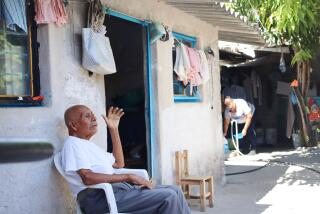In Tijuana, it’s cop vs. cop
The two police forces eyed each other across the narrow downtown street.
On one side of 8th Street, city cops formed a line in front of their headquarters.
On the other, 30 masked state police officers dressed in black faced them, holding weapons.
City police had detained two state agents for allegedly threatening the mayor’s bodyguards.
The state police had come to free the two. They marched forward and tried to shoulder their way inside the building.
The standoff last year, which ended when city police released the agents, was one of several incidents that have pitted police force against police force in a conflict that seems to have deepened with each car chase and raid.
Armed confrontations between law enforcement agencies are nothing new in Mexico, where police often take the sides of rival drug cartels. But in Tijuana the friction is at least partly a political fight between the National Action Party, also known as PAN, and the Institutional Revolutionary Party, or PRI.
A period of relative harmony was broken when Jorge Hank Rhon, the PRI candidate, took office as mayor in late 2004 and hired his own police chief to run the 2,750-member municipal department, which the PAN had controlled for more than a decade. Baja California Gov. Eugenio Elorduy Walther of the PAN remained in charge of Tijuana’s state police force, which includes 450 investigators and a highly trained rapid-response team.
The opposing parties have said they are a unified front against criminal drug cartels, but the police rivalry has exposed a troubling level of disarray.
Both police forces have been heavy-handed. In March 2005, city police surrounded state police headquarters and at gunpoint freed two of their officers who had been detained in a homicide investigation.
Last month, city cops again surrounded the state police building after agents detained a city cop. And over the last year and a half, there have been at least half a dozen confrontations between state agents and city police assigned as bodyguards to Rhon.
The police infighting couldn’t have come at a worse time. In the city of about 1.5 million people, drug cartels are fighting for control of lucrative trafficking routes. Many upper and middle-class residents are moving out to avoid being targeted by kidnap-for-ransom rings. Rampant drug addiction is fueling a surge of car thefts and robberies.
Because public safety remains the most important issue for residents, perceptions of police can shape political destinies, causing agencies to try to outdo or embarrass each other. “Each police force tries to show progress and achievements while attempting to criticize and embarrass the other force ... and the only groups benefiting from this situation are the crime rings,” said Jose Maria Ramos, the director of the school of public administration at Tijuana’s College of the Northern Frontier.
After Rhon’s municipal police chief took over, the agencies’ areas of responsibility began to blur. State authorities are in charge of investigations, but municipal cops started expanding their turf and pursuing their own investigations in an effort to win over public opinion. They said they had to be more aggressive in a city overrun by crime.
The feuding flared on busy thoroughfares when state agents started intercepting the mayor’s motorcade of SUVs, which were filled with heavily armed bodyguards. The mayor’s supporters called it harassment, but state police said the cars weren’t registered. They said they had to watch such convoys closely because they fit the profile of organized-crime hit squads that carry out kidnappings and assassinations throughout the city.
Each confrontation between the forces received ample coverage in local newspapers, and some PRI politicians called the stops an orchestrated campaign to embarrass the mayor.
Police relations worsened in January when Mexican President Felipe Calderon dispatched thousands of soldiers and federal agents to the city. The general in charge of “Operation Tijuana” ordered city police to turn in their weapons while the officers were inspected for links to organized crime.
City cops protested by patrolling with slingshots hanging from their holsters, complaining that the anti-corruption inspections should be extended to the state police.
Rhon stepped down as mayor in February, ending his tense cross-town motorcades -- and things have calmed down since, said Victor Manuel Zatarain, the city police chief. He and other law enforcement officials say that cooperation and coordination between the agencies have improved, especially in emergency situations.
But some experts say deep divisions still undermine efforts to thwart organized crime. When several gunmen attacked Tijuana’s General Hospital in April to free a wounded ally, for example, most of them escaped, despite a supposed joint operation by state and municipal police.
With the state gubernatorial campaign set to start this summer, experts say police relations are likely to become more strained. Minor incidents still flare into tense confrontations, as was evident last month when state agents detained a city cop for allegedly carrying an unlicensed weapon. When Zatarain showed up at the state police building to clear things up, he brought seven bodyguards. About two dozen other city police officers surrounded the building and blocked off streets around the area, state police said.
Soon after city police took up their positions, about 50 state police reinforcements arrived, and the two heavily armed forces ended up staring each other down for about one hour outside the headquarters.
More to Read
Start your day right
Sign up for Essential California for news, features and recommendations from the L.A. Times and beyond in your inbox six days a week.
You may occasionally receive promotional content from the Los Angeles Times.







